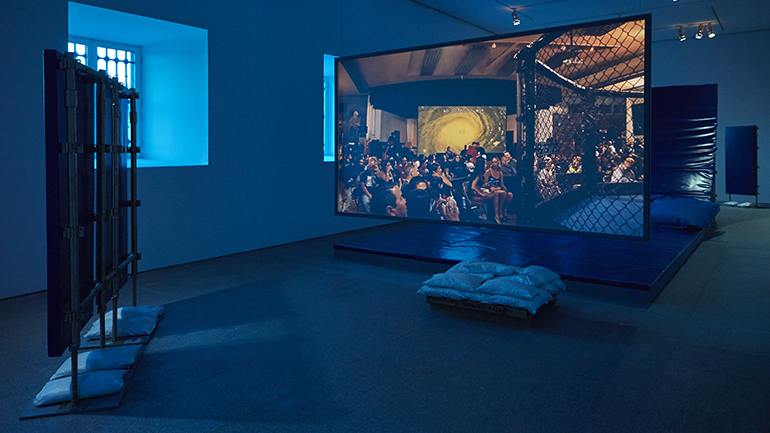


Hito Steyerl, Duty-Free Art, installation view, Museo Nacional, Centro de Arte Reina Sofia, Madrid, 2015. Courtesy the artist and Andrew Kreps Gallery, New York. Image courtesy Museo Nacional, Centro de Arte Reina Sofia, Madrid.
Hito Steyerl’s current exhibition in Madrid offers the most comprehensive view to date of the work of an artist with arguably the sharpest analysis of our particular moment in history. The Reina Sofía has brought together seven works, spanning from November, 2004, to Is the Museum a Battlefield?, 2013, and Duty-Free Art, 2015, allowing the viewer the opportunity to track Steyerl’s developing thesis through the ensemble of densely argued video lectures. Anything less than a full commitment to watching these extended works will likely leave you clueless, as Steyerl’s elaborate, playful and incisive disquisitions require sustained attention to fully deliver their punches.
The artist’s engagement with the most current modalities of digital media and developments in international finance and politics are what initially hook the viewer through their unavoidable contemporaneity. At the same time these elements are what also draw us deeper to follow lines of argument that connect exhibitions at such venerated institutions as the Art Institute of Chicago, to the current tragic war in Syria, via spent shell casings in Afghanistan.
The biggest installation here, Liquidity inc., 2014 invites the viewer to settle comfortably into giant blue bean bags to consider a video essay that interrogates its subject from a wittily various series of points of view. The work pivots apparently on the biography of one Jacob Wood, adopted out of Vietnam as a baby in 1974 and who grew up in the US to be a financial trader, until the collapse of Lehmann Bros in 2008 saw him made redundant overnight. Finding a way to turn his interest in martial arts into a career, the aphorisms of the late, great Bruce Lee provided guidance more than three decades after his death: ‘be water, my friend’, ‘water can flow and water can crash’.
November, 2004, the early film that examines the undocumented death of Steyerl’s childhood friend Andrea Wolf also references Bruce Lee. Lee, the archetypal martial arts hero, the itinerant warrior, defender of oppressed peoples, is connected to the potency of the image of Wolf, a ‘travelling image’ used in demonstrations in Turkey after her death. It is one of the strengths of this exhibition that it makes it possible to track these key orientation points for the artist across more than a decade of work.
In Liquidity inc., Steyerl makes one of her characteristic intellectual leaps and connects extreme financial events to extreme climate events: the jet stream of money changes direction when the Dow Jones collapses, then suddenly a gonzo weather forecaster, masked in black, is gesturing across the most political of politically geographical maps you ever saw – noting failed states and off-shore tax havens, isobars indicating flows of capital rather than weather fronts. Pinterest animations of Hokusai’s famous tsunami wave fill the screen, followed swiftly by shots of fearless surfers wiping out in the most giant of tubes.
The artist’s most recent essay for e-flux Journal makes it clear that the experience of making the show at the Reina Sofía was a powerful one: to do so in the home of Picasso’s masterpiece Guernica offered an irresistible context for her more recent meditations on the continuities between the international artworld and the business of conflict. In Is the Museum a Battlefield? 2013, Steyerl tracks the otherwise tacit connections between the big business of arts sponsorship and the manufacture of military hardware, taking in the political dimension of the shifting balance between public and private sponsorship of museums.
After the proliferation of private museums in the recent years, Steyerl links back to the origins of the institution of the museum in the princely collections of the 18th century. Duty-Free Art, 2015, reveals the international Freeport as perhaps the most critical site for art in our era: an increasing number of giant storage facilities that allow artworks to be legally in perpetual transit, thus avoiding scrutiny and tax. Steyerl posits international biennales and art fairs as merely the acceptable top layer of a “dark web” of commerce that, if one searches far enough, incorporates all of our global conflicts.
Caroline Douglas
Director
Hito Steyerl, Duty-Free Art, Sabatini Building, Floor 3, Museo Nacional, Centro de Arte Reina Sofia, Calle Santa Isabel, 52, Madrid 28012.
Open Monday 10.00-21.00, Wednesday - Saturday 10.00 - 21.00, Sundays check for times, closed Tuesdays. Exhibition continues until 21 March 2016.